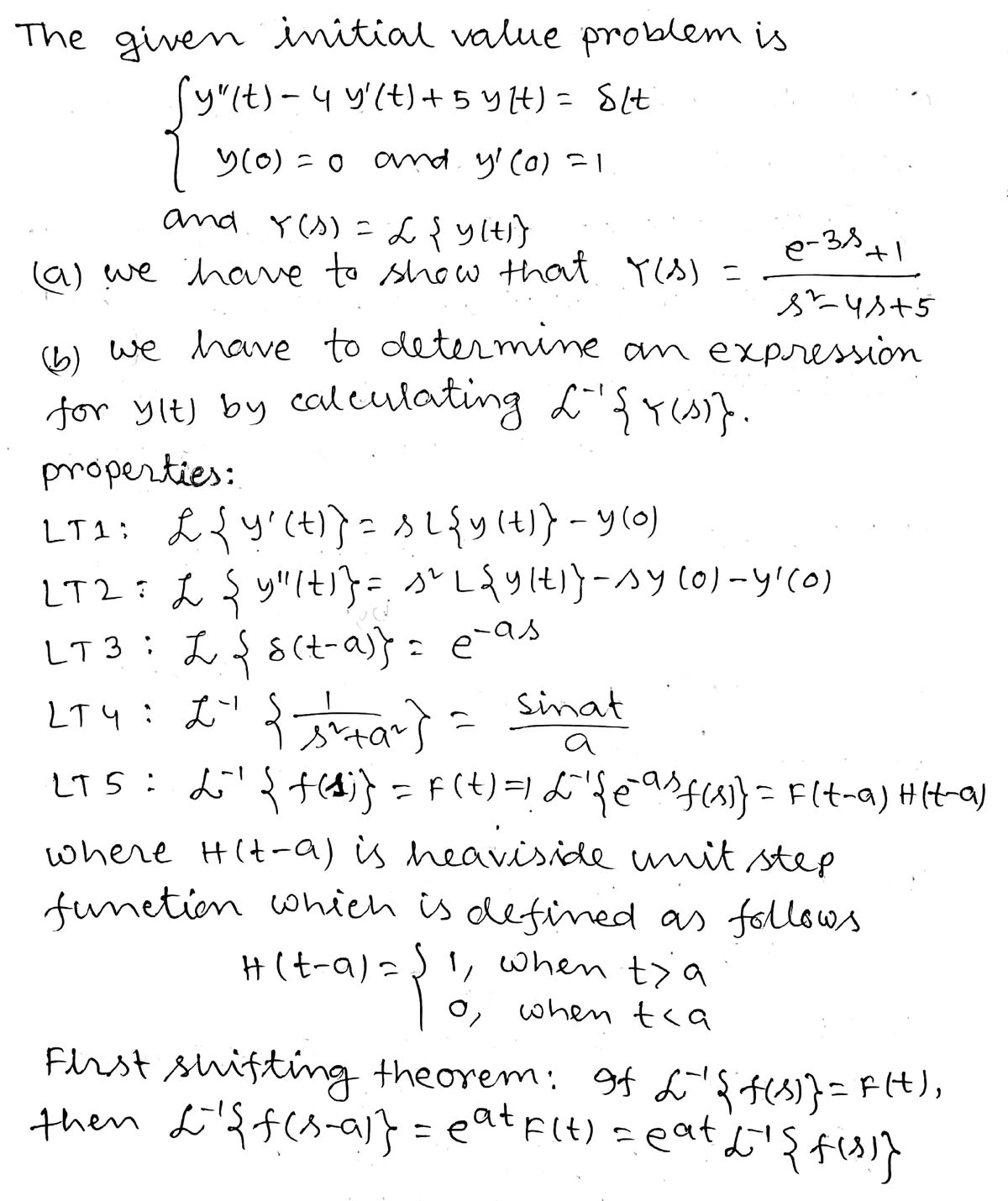Suppose y satisfies the initial value problem fy" (t) = 4y' (t) + 5y(t) = 8(t − 3) y(0) = 0 and y'(0) = 1 Where is the delta function. Let Y(s) = : L{y(t)}. (a) By taking the Laplace transform of the ODE, show that how that Y(s) = (b) Determine an expression for y(t) by calculating ¹ {Y(s)} e-3s +1 s² - 4s + 5 Note: State each Laplace transform property as you use it. Refer to each property using its row number in the Table of Laplace Transforms provided. For example: "L{1} : by [LT1]"
Suppose y satisfies the initial value problem fy" (t) = 4y' (t) + 5y(t) = 8(t − 3) y(0) = 0 and y'(0) = 1 Where is the delta function. Let Y(s) = : L{y(t)}. (a) By taking the Laplace transform of the ODE, show that how that Y(s) = (b) Determine an expression for y(t) by calculating ¹ {Y(s)} e-3s +1 s² - 4s + 5 Note: State each Laplace transform property as you use it. Refer to each property using its row number in the Table of Laplace Transforms provided. For example: "L{1} : by [LT1]"
Advanced Engineering Mathematics
10th Edition
ISBN:9780470458365
Author:Erwin Kreyszig
Publisher:Erwin Kreyszig
Chapter2: Second-order Linear Odes
Section: Chapter Questions
Problem 1RQ
Related questions
Question
100%
![Suppose y satisfies the initial value problem
ƒ y" (1) − 4y' (1) + 5y(t) = 8(t − 3)
1 y(0) = 0 and y'(0) = 1
Where is the delta function. Let Y(s) = L{ y(t)}.
(a) By taking the Laplace transform of the ODE, show that how that Y(s) =
(b) Determine an expression for y(t) by calculating £¯¹ {Y(s)}
=
e-3s +1
s² - 4s +5
Note: State each Laplace transform property as you use it. Refer to each property using its row number in the Table of Laplace
Transforms provided. For example: "L{1}
by [LT1]"](/v2/_next/image?url=https%3A%2F%2Fcontent.bartleby.com%2Fqna-images%2Fquestion%2F0aad4bd6-f67d-4613-88de-9ea67499279b%2Ffc04138d-d1a9-4891-a8b6-3d0fcaa68672%2Fmipn7vk_processed.jpeg&w=3840&q=75)
Transcribed Image Text:Suppose y satisfies the initial value problem
ƒ y" (1) − 4y' (1) + 5y(t) = 8(t − 3)
1 y(0) = 0 and y'(0) = 1
Where is the delta function. Let Y(s) = L{ y(t)}.
(a) By taking the Laplace transform of the ODE, show that how that Y(s) =
(b) Determine an expression for y(t) by calculating £¯¹ {Y(s)}
=
e-3s +1
s² - 4s +5
Note: State each Laplace transform property as you use it. Refer to each property using its row number in the Table of Laplace
Transforms provided. For example: "L{1}
by [LT1]"
Expert Solution
Step 1

Step by step
Solved in 3 steps with 3 images

Recommended textbooks for you

Advanced Engineering Mathematics
Advanced Math
ISBN:
9780470458365
Author:
Erwin Kreyszig
Publisher:
Wiley, John & Sons, Incorporated

Numerical Methods for Engineers
Advanced Math
ISBN:
9780073397924
Author:
Steven C. Chapra Dr., Raymond P. Canale
Publisher:
McGraw-Hill Education

Introductory Mathematics for Engineering Applicat…
Advanced Math
ISBN:
9781118141809
Author:
Nathan Klingbeil
Publisher:
WILEY

Advanced Engineering Mathematics
Advanced Math
ISBN:
9780470458365
Author:
Erwin Kreyszig
Publisher:
Wiley, John & Sons, Incorporated

Numerical Methods for Engineers
Advanced Math
ISBN:
9780073397924
Author:
Steven C. Chapra Dr., Raymond P. Canale
Publisher:
McGraw-Hill Education

Introductory Mathematics for Engineering Applicat…
Advanced Math
ISBN:
9781118141809
Author:
Nathan Klingbeil
Publisher:
WILEY

Mathematics For Machine Technology
Advanced Math
ISBN:
9781337798310
Author:
Peterson, John.
Publisher:
Cengage Learning,

